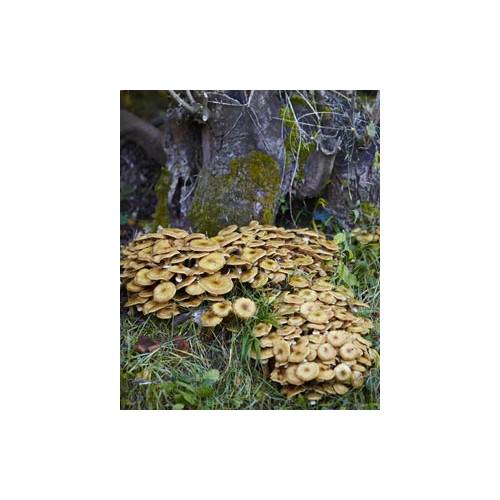
Fungus
Honey fungus
- Details
-
It attacks the plants in a rather underhand way, targeting their roots. It is one of the most dangerous diseases and the attacked plants often die. In reality there are several types of honey fungus, all of them are harmful and very contagious!
The symptoms
Unfortunately, the main symptom of infection by honey fungus is the sudden death of the plant. The development of the fungus underground goes unnoticed in the early stages. The plants that have been attacked for a period of time may have clumps of mushrooms growing around their base, sometimes even after their death. Occasionally the plant may be blown over by the wind before dying because its roots have been weakened underground. Be careful, not all mushrooms growing around a plant mean that it is in danger, often the contrary! Only a small number pose a risk.
Lifecycle
The attack by honey fungus always begins in the same way: a damaged root offers an opening for the filaments of the fungus, which patrol the soil looking for any opportunity. When it gets in to the plant, the fungus infests the roots and starts to breakdown the plant tissue. Little by little, its hold will tighten and it will end up killing the plant by depriving it of its roots. If the colony is large then the filaments will send up mushrooms (the visible part of the fungus) to reproduce. The infection is more contagious via the filaments in the ground than by the germs transported in the air.
How to fight it
It is difficult to care for an infected plant; this is often because it is too late when the disease is noticed. Only a systematic fungicide, meaning one that will diffuse through the entire plant can prolong the life of the subject. It consists of using a chemical treatment that must not be used on fruit trees and should only be used in certain cases. It is wiser to pull out the plant infected by the honey fungus and burn it. Make sure that you only grow plants that are suitable for the type of soil that you have especially if it is clay or damp.
How to avoid it
There are several ways to prevent the attacks of honey fungus. In a well-worked soil, the air will penetrate to greater depths and where there is no stagnant water in winter the chance of attacks are less. In contrast, a soil that is swimming in water or where there is insufficient drainage has a much greater risk of honey fungus infection. An acidic soil is another risk factor that can be lessened by spreading lime on the soil at the end of winter each year. Certain plants are also more susceptible to attack by honey fungus than others are: Californian lilacs, rhododendron and Japanese maples are the most vulnerable. Oaks and elders are on the other hand very resistant.
Good to know
The presence of tree stumps left in the ground and not pulled out provides an ideal place for honey fungus to reproduce and spread to neighbouring plants. It is highly recommended that tree stumps be removed before planting nearby. It is indeed a big job to remove the stump after having cut the tree down, but it is worth the effort for the well-being of the other plants! - Photos (1)

